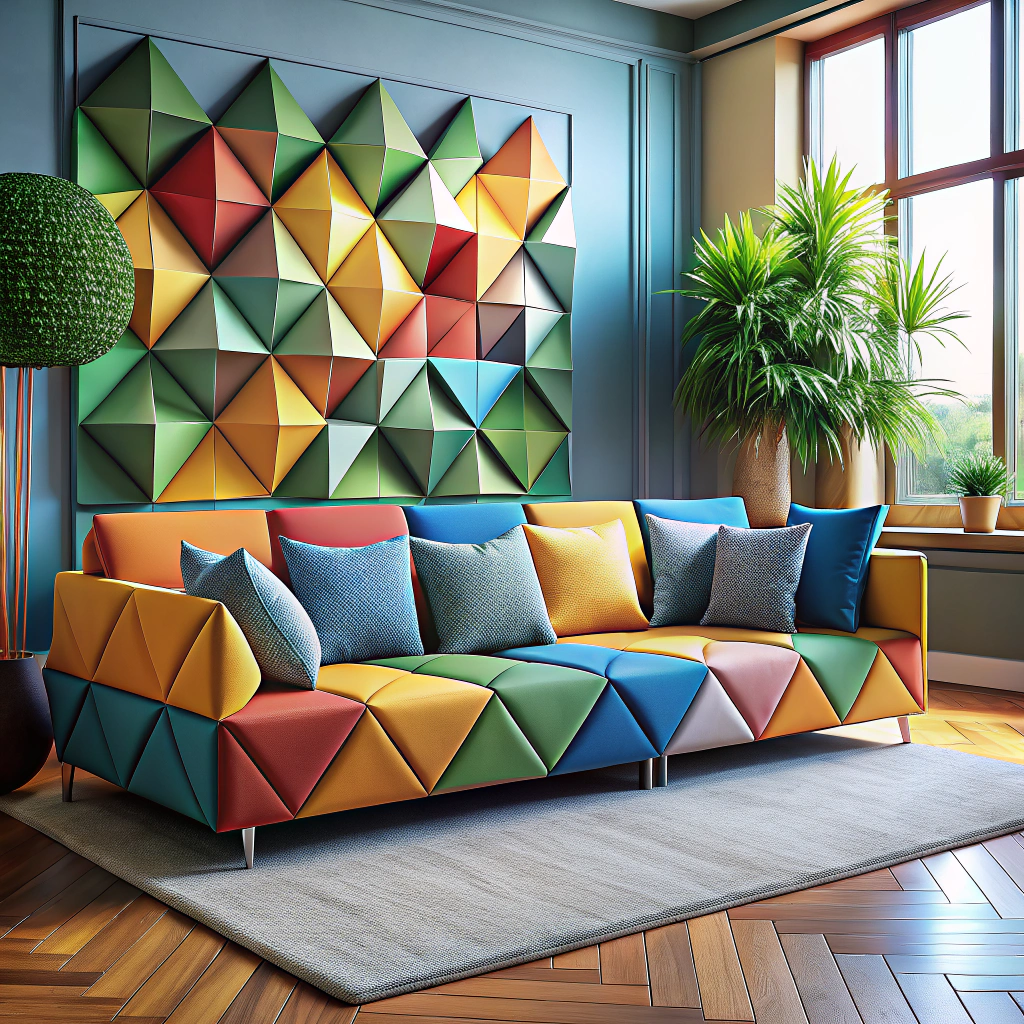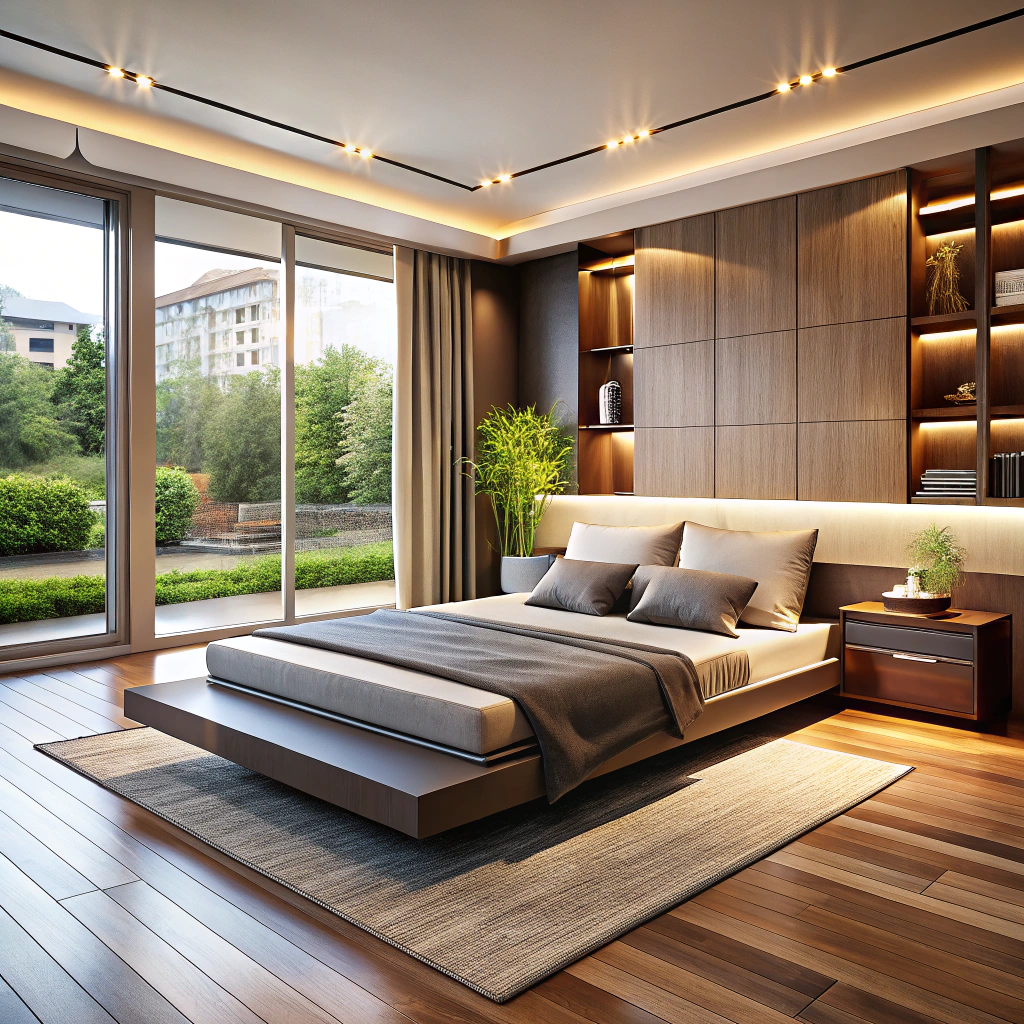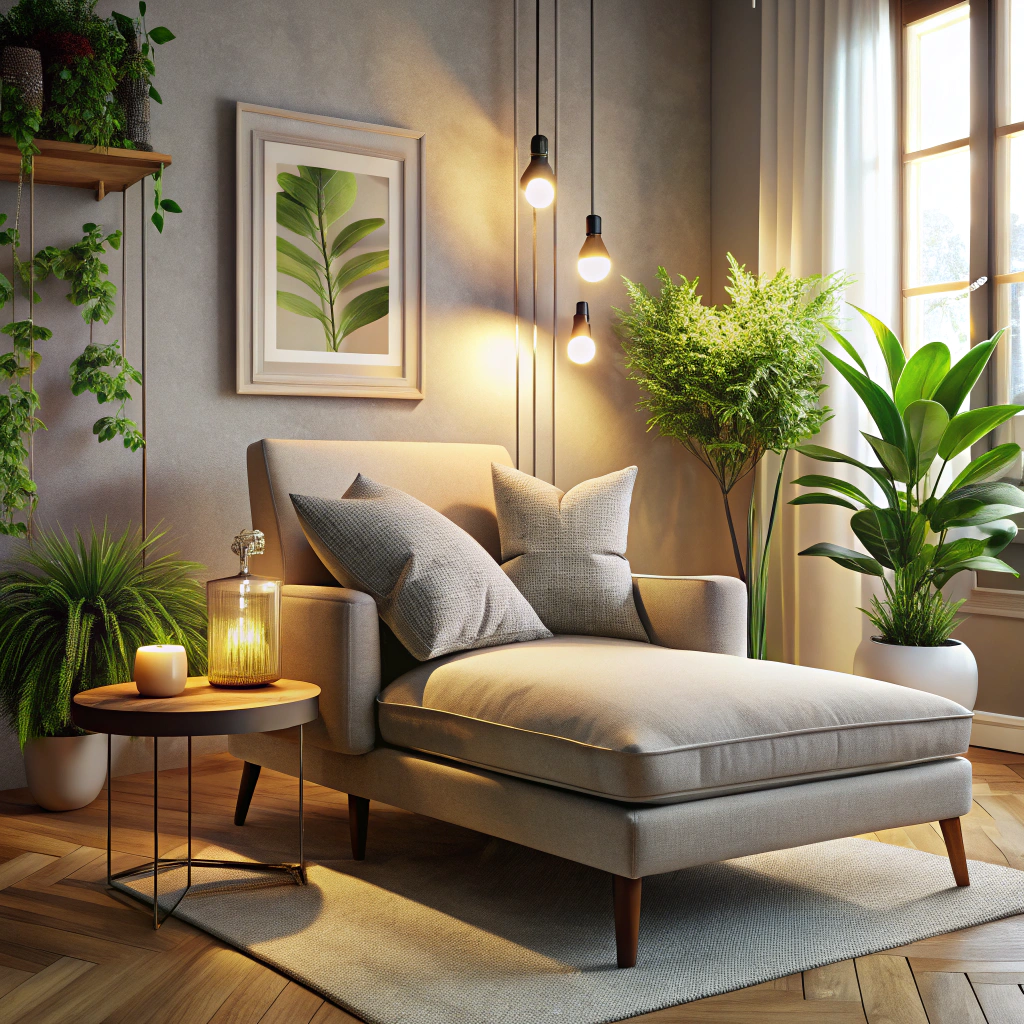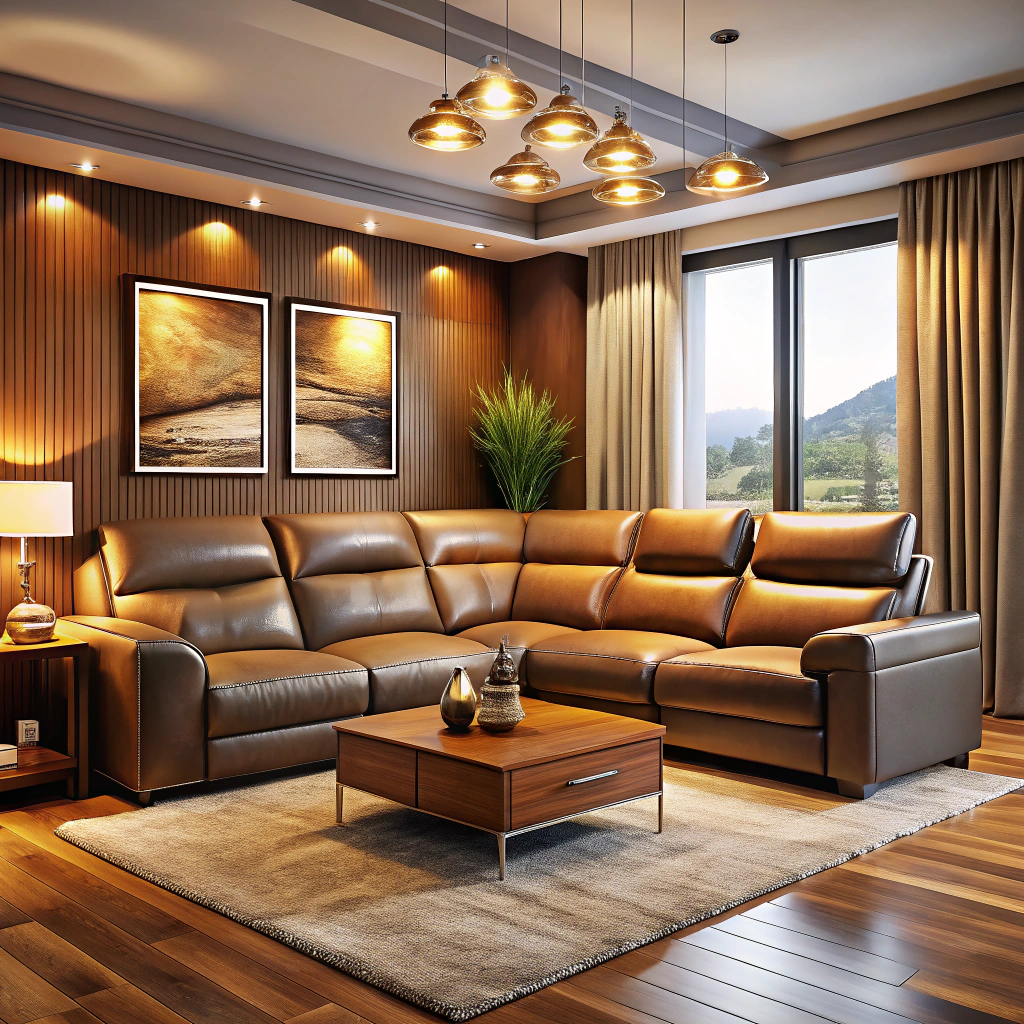Last updated on
Experience the unparalleled comforts of home, because this article details the innovative ideas that can turn every nook and corner into a personal sanctuary.
Creating a sanctuary of comfort in your home is more than a matter of taste—it’s an art that nourishes the soul and rejuvenates the spirit.
From enveloping your senses in soothing textures and fabrics to orchestrating furniture that whispers relaxation, every detail contributes to your haven.
Imagine a home that not only looks inviting but also feels like an embrace with its layered lighting, life-infusing plants, and colors that influence your mood.
Whether you’re looking to transform a space or enhance your existing decor, this guide is your companion in weaving comfort and serenity into the very fabric of your home, with practical advice tailored to enrich your living experience.
Key takeaways:
- Comforting Textures and Fabrics: Layer different textures in your living space for a cozy atmosphere. Select fabrics that invite touch and contribute to overall wellbeing. Harmonize colors and patterns for visual comfort.
- Optimal Furniture Arrangements for Relaxation: Create clear pathways and reduce clutter. Arrange seating for conversational layouts and natural light. Choose scale-appropriate furniture for smaller areas. Incorporate multifunctional pieces for organization.
- Layering Lighting for Ambiance and Function: Utilize a mix of light sources at varying levels. Experiment with dimmer switches and color temperature. Play with shadows and incorporate reflective surfaces.
- Incorporating Plants for a Living Environment: Choose air-purifying plants that complement any decor. Consider light requirements and watering needs. Use hanging planters, wall-mounted greenery, or potted plants. Opt for low-care succulents or high-quality faux plants.
- Color Psychology in Home Decor: Use cool colors for calmness, warm colors for energy, and neutrals for versatility. Consider personal experiences and desired emotions.
Table of Contents
Comforting Textures and Fabrics
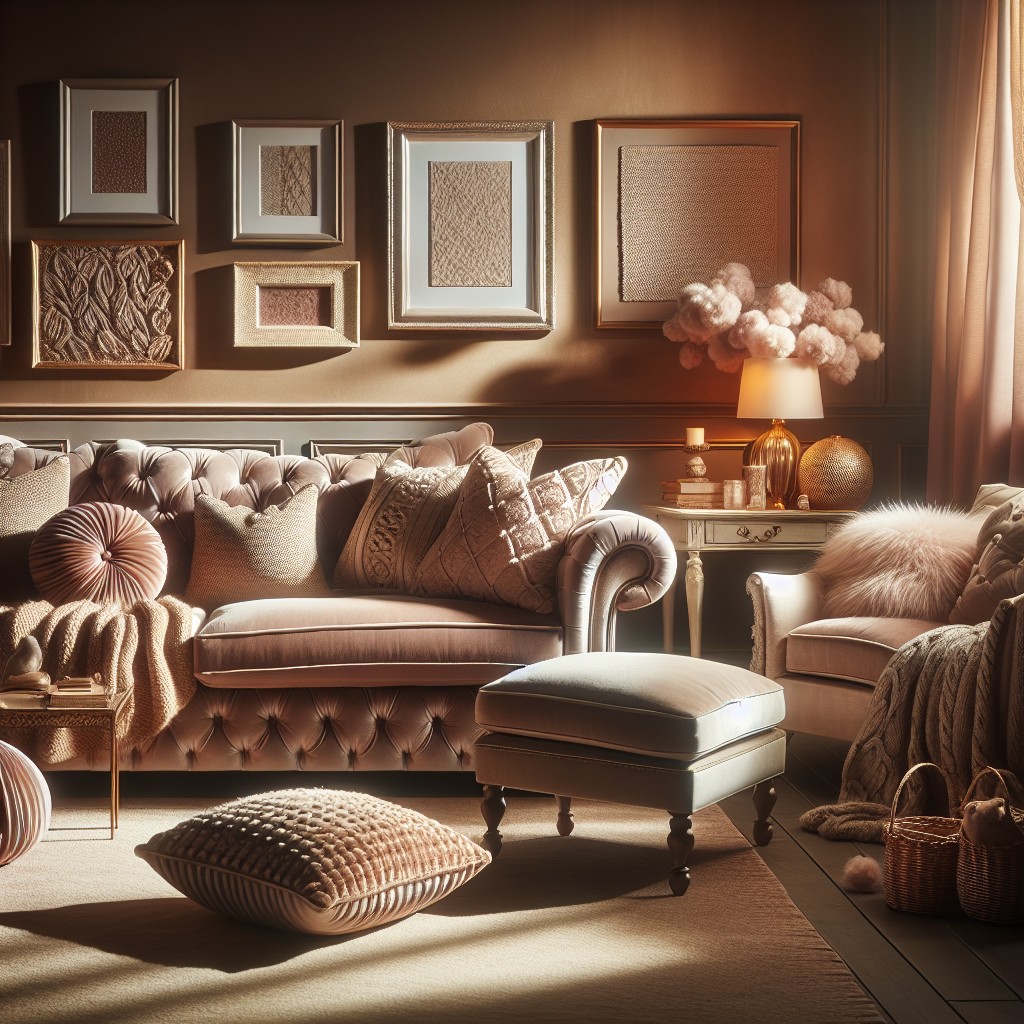
Soft chenille throw blankets and plush velvet pillows provide an instant tactile experience driving comfort in your living spaces. To elevate this sensation, consider layering different textures to create depth and interest.
Wool rugs underfoot offer warmth and a soft landing, perfect for cooler months, while lighter cotton throws are ideal for snuggling up during a breezy summer evening. Don’t forget the sensory appeal of fabrics like silk and linen that bring a touch of elegance along with comfort.
Select materials that not only invite touch but also contribute to overall wellbeing—hypoallergenic options like bamboo or organic cotton can be beneficial for sensitive skin. Additionally, incorporating durable yet cozy upholstery fabrics such as microfiber or leather adds practicality as they are easy to clean and maintain.
Visual comfort counts too; harmonize colors and patterns in your textiles to ensure they complement rather than clash, promoting a serene atmosphere.
Optimal Furniture Arrangements for Relaxation

Mastering the art of furniture placement can dramatically enhance the tranquility of your living space. A key strategy is to focus on creating clear pathways and reducing clutter to foster ease of movement.
Position your sofas and chairs in a conversational layout, ensuring each seat has a delightful view or focal point, such as a fireplace or artwork. Coffee tables should be accessible without effort, ideally 18 inches from seating, allowing for comfortable reach.
Consider the flow of natural light and arrange seating to take advantage of warm, sunny spots for an uplifting ambiance. In smaller areas, choose scale-appropriate furniture to avoid a cramped feeling. Multifunctional pieces, like ottomans with storage, can also aid in maintaining a serene, organized atmosphere.
Remember, your space should not only look inviting but also intuitively guide relaxation and social interaction.
Layering Lighting for Ambiance and Function
Utilize a mix of light sources at varying levels to create depth and warmth in a room. Overhead lighting provides general illumination, while task lights like reading lamps or under-cabinet lighting in kitchens serve specific purposes. Accent lights, such as picture lights or LED strip lighting, add drama by highlighting artwork or architectural features.
Experiment with dimmer switches to adjust the brightness according to the time of day or desired mood. They are particularly effective in dining areas and living rooms, where versatility is key.
Consider the color temperature of light bulbs. Warmer yellow-toned lighting creates a cozy, welcoming atmosphere, whereas cooler blue-toned light is energizing and better suited for concentration in home offices or kitchens.
Play with shadows to add mystery and interest. Use directional lighting to cast shadows on walls or ceilings for a dynamic effect, but avoid placing lights directly above seating areas to prevent harsh shadows on faces.
Incorporate reflective surfaces such as mirrors or glossy finishes to bounce light around the room, making spaces feel larger and lighter.
Incorporating Plants for a Living Environment
Adding greenery to your home does more than just beautify the space. Plants can improve air quality by filtering toxins and releasing oxygen.
Choose species like snake plants and spider plants for their air-purifying abilities.
Apart from health benefits, the varying shades of green create a serene and natural palette that can complement any decor.
Consider the light requirements and watering needs of each plant to ensure they thrive in your space.
Use hanging planters, wall-mounted greenery, or simple potted plants to add life to corners.
For those less inclined to maintenance, opt for low-care succulents or even high-quality faux plants that provide the aesthetic without the upkeep.
Remember, the goal is to create an oasis of calm, so avoid overcrowding—allow each plant room to breathe, serving both as decor and a living, breathing element of your home.
Color Psychology in Home Decor
Harnessing the power of color helps shape the atmosphere of your home. Cool blues and greens instill a sense of calm, making them ideal for bedrooms and bathrooms where serenity is paramount.
In contrast, vibrant reds and oranges inject energy, suitable for spaces designed for socializing or physical activity. Yellows evoke happiness and are best utilized in kitchens or breakfast nooks where a sunny disposition starts the day off on the right foot.
For those seeking a backdrop that encourages concentration and opens up the flow of communication, shades of purple or light blues in a study or home office can be beneficial.
Meanwhile, neutral tones such as beige, grey, and whites offer a canvas that allows for versatility in decor, allowing textures and accent colors to pop without overwhelming the senses.
Remember, the psychological impact of color is personal and can vary based on individual experiences. It’s important to consider the emotions and mood you want to foster in each room before diving into a new color scheme.
Creating a Reading Nook or Quiet Space
Select a secluded spot away from high-traffic areas to establish serenity. A corner in the bedroom or living room often works well.
Ensure the space has sufficient lighting; a combination of natural light during the day and a soft lamp or reading light for evening hours enhances readability and creates a cozy atmosphere.
Choose a comfortable chair that supports good posture, paired with an ottoman or footrest for added relaxation.
Add a side table to keep books, a cup of tea, or reading glasses within arm’s reach.
For extra coziness, incorporate plush pillows and a throw blanket.
Consider sound-dampening elements like a thick rug or heavy curtains to muffle outside noise.
Lastly, personalize the nook with a few favorite decorative items or wall art to make the space uniquely yours.
Investing in Quality Bedding
A good night’s sleep starts with the right foundation. High-thread-count sheets may feel luxurious, but it’s the material that makes the difference. Choose cotton or bamboo for breathability and comfort year-round.
Memory foam or latex pillows provide support for various sleeping positions, so assess your sleep style before purchasing.
The comforter or duvet you select has a significant impact on sleep quality. Down fill offers traditional warmth with a lightweight feel, while alternative down is hypoallergenic and often more affordable. Consider a duvet with a washable cover for ease of cleaning and the option to switch up styles without replacing the entire comforter.
Your mattress should not be overlooked; it’s the cornerstone of comfort. Memory foam contours to the body, while innerspring mattresses offer firmer support. A hybrid option might be the best of both worlds. While higher initial costs might suggest luxury, view quality bedding as an investment in your well-being. After all, improved sleep leads to better overall health.
Designing an Inviting Entryway
The entryway sets the tone for your entire home, greeting guests with a taste of your personal style. To create a warm, welcoming space:
- Use a console table to anchor the area, allowing space for key drop-offs and decorative touches such as vases or photo frames.
- Choose a durable, stylish rug to introduce texture and pattern while withstanding foot traffic.
- Incorporate a mirror to reflect light and provide a spot for last-minute appearance checks.
- Select a lighting fixture that complements the home’s overall aesthetic, ensuring a well-lit entrance.
- Add a seating option, like a bench or chair, for convenience when removing shoes.
- Utilize wall hooks or a coat stand to keep outerwear organized and accessible.
Remember that every item should serve a purpose, contributing to a cohesive and functional welcome area.
Organizing for Ease and Accessibility
Streamlining your living space can drastically improve your daily routine, making it stress-free and efficient. Consider these actionable tips:
1. Declutter Regularly: Start by clearing out items you no longer use or need. A minimalist approach can reduce chaos and promote tranquility.
2. Use Clear Storage: Transparent bins allow you to see contents at a glance, saving time and effort in locating items.
3. Label Everything: Assigning labels to shelves and boxes can guide you instantly to what you’re looking for, and makes it easier for everyone else at home to follow the system.
4. Utilize Vertical Space: Install shelves or hang organizers to free up floor space and keep daily-use items within arm’s reach.
5. Adapt for Accessibility: Place frequently used objects on lower shelves for easy access, while seasonal or rarely used items can be stored higher up.
6. Establish a Drop Zone: Designate an area near the entrance for keys, mail, and shoes to keep essentials organized and prevent clutter from spreading throughout your home.
7. Invest in Multi-functional Furniture: Pieces like ottomans with storage or beds with built-in drawers offer additional space without taking up more room.
8. Routine Maintenance: Dedicate a few minutes each day to return items to their designated spots. This habit keeps your organization system effective and your space clean.
Personalizing Workspace for Comfort and Productivity
Choose an ergonomic chair that supports your posture and invest in a desk at the appropriate height to prevent strain. Pair with a footrest if necessary for added comfort.
Arrange your monitor or laptop screen at eye level using a stand or a stack of books to alleviate neck stress.
Select a harmonious color palette for your workspace that inspires productivity; muted blues or greens can have a calming effect, while pastels might boost creativity.
Integrate personal items such as family photos, artwork, or souvenirs that spark joy but avoid clutter by keeping them contained or selectively placed.
Incorporate desk plants or succulents to purify the air and add a touch of nature, which can increase focus and reduce stress.
Use desk organizers and cord management solutions to keep your workspace tidy, as a clutter-free area promotes a clear mind.
Invest in good lighting; a mix of natural light and adjustable desk lamps can reduce eye strain and create a warm and inviting work environment.
Utilize noise-canceling headphones or soft background music to help drown out distracting noises, especially in busy households or shared spaces.
Ensure your workspace is separated from relaxation areas to establish a clear boundary that mentally prepares you for work mode.
Innovative Storage Solutions
Embrace the magic of dual-purpose furniture, where beds with built-in drawers or ottomans with storage compartments transform living areas into clutter-free havens. Maximize vertical space by installing floating shelves above doorways or in long, narrow corridors, making use of often-overlooked areas.
Consider pull-out cabinets in your kitchen and bathroom for accessibility and to make full use of deep spaces. For wardrobes, use slimline hangers and multiple-tiered hanging inserts to increase hanging space. In children’s rooms, try colorful, labeled bins on low shelves, marrying tidiness with easy clean-up routines.
Wall-mounted magnetic strips or pegboards turn tools and utensils into wall art while keeping them handy. Remember that well-planned storage not only clears the clutter but also adds to the aesthetic of a harmonious home.
Seasonal Decor Changes for Refreshed Comfort
Transitioning your home decor with the changing seasons can revitalize your living space and reflect the outside world’s evolving beauty. Consider these points to embrace seasonal decor:
- Swap out throw pillows and blankets with season-appropriate colors and materials; lightweight linens for summer and cozy wools for winter.
- Introduce seasonal plants and flowers to infuse life and fresh scents into your home, such as daffodils in spring or evergreen boughs in winter.
- Update your table setting with thematic elements, like bright placemats for spring or rustic centerpieces in autumn.
- Adjust your curtain fabrics to fit the weather, using airy sheers during warmer months and heavier drapes for colder times.
- Display seasonal wall art, or family photos from seasonally-relevant events, creating a dynamic visual narrative.
- Revamp your mantel or shelves with seasonal items, such as shells and sea glass for summer, or pine cones and candles for fall.
Smart Home Devices for Added Convenience
Embrace the ease of voice-activated assistants to manage daily tasks with a simple command. Picture adjusting the thermostat, turning off lights, or playing music without lifting a finger.
Smart plugs offer the ability to retrofit traditional appliances for smart control, streamlining energy usage and providing convenience.
Scheduling capabilities found in many smart devices can automate home routines, ensuring a warm cup of coffee awaits you each morning or that your living space is the perfect temperature when you arrive from work.
Consider installing security cameras and smart locks, which not only bolster home security but also allow remote monitoring and access, giving you peace of mind whether you’re home or away.
Lastly, look into smart cleaning gadgets such as robotic vacuums and mops, which keep floors pristine, affording you more time to enjoy your sanctuary.
Cultivating a Kitchen Space for Comfort Cooking
A well-cultivated kitchen invites culinary exploration with ease. Ensure that work surfaces are ample and uncluttered, promoting a functional flow during meal prep.
Choose ergonomic tools and appliances that cater to frequent use, reducing physical strain. Optimize storage through pull-out cabinets or hanging racks for easy access to pots, pans, and ingredients.
Integrate seating areas, such as a kitchen island with bar stools, to encourage social interaction while cooking. Select soothing color schemes and install under-cabinet lighting to create a warm and welcoming atmosphere.
Keep your favorite recipes within reach with a dedicated cookbook display or tablet stand. Embrace the incorporation of fresh herbs on a windowsill or a small indoor garden to add both flavor and greenery to your space.
Prioritize maintenance with surfaces and materials that are easy to clean, ensuring that the kitchen remains a comforting hub of your home.
Maximizing Natural Light
Harness the full potential of the sun’s rays by strategically placing mirrors opposite windows to bounce light into darker corners. Sheer curtains allow for light filtration while maintaining privacy, and choosing the right window treatment can make a significant difference. Opting for lighter paint colors, particularly in matte finishes, can also reflect light rather than absorbing it.
For those with the means to do so, consider installing skylights or solar tubes in areas like hallways and bathrooms that often lack natural light sources. Remember, keeping windows clean is a simple yet effective method to ensure maximum brightness in your living spaces. Remember to periodically rearrange furniture to avoid blocking windows and to open up the flow of light.
Comforts in a Pet-Friendly Home
Ensuring your home is pet-friendly contributes significantly to the comfort of both you and your furry friends. Start with pet-safe furniture materials, such as leather or tightly woven fabrics, to withstand the wear and tear from claws and paws. When selecting flooring, consider scratch-resistant options like ceramic tile or treated hardwood, and add slip-resistant rugs for extra pet traction.
An allocated feeding station helps keep mealtime tidy and organized—opt for non-slip mats beneath water and food bowls to catch any spills. Invest in a pet bed that complements your decor while providing a dedicated spot for your pet to relax. This can help keep fur and dander confined to one area, making cleaning more manageable.
Remember to carve out a specific storage space for pet supplies, such as toys, grooming tools, and treats. Having a particular drawer or bin makes these items easily accessible while maintaining a clutter-free environment.
Finally, introduce a pet relief area if you have outdoor space. A patch of grass or a specially designed pet potty can be a designated zone for bathroom breaks, ensuring the rest of your garden remains pristine for human enjoyment.
Prioritizing Comfort in Outdoor Living Spaces
To cultivate an inviting outdoor living area, consider these points:
- Invest in weather-resistant seating with plush, removable cushions for easy cleaning.
- Arrange furniture to foster conversation, such as a circular layout around a fire pit.
- Add outdoor rugs to define spaces and provide warmth underfoot.
- Incorporate throw blankets for chilly evenings, stored in waterproof bins when not in use.
- Install adjustable shading solutions, like retractable awnings or umbrellas, for comfort in various weather conditions.
- Include soft lighting options — solar LED lights and lanterns create a cozy atmosphere post-sunset.
- Introduce elements of water, such as fountains, for a soothing auditory backdrop.
- Choose low-maintenance plants that contribute greenery without added stress.
- Consider the installation of a hot tub or outdoor sauna for a luxurious relaxation option.
- Ensure there’s ample surface space, like side tables or a coffee table, for convenience.
Enhancing Indoor Air Quality
Cleanliness is the cornerstone of maintaining good indoor air quality. Regular dusting and vacuuming with HEPA-filter equipped appliances reduce allergens and irritants. Incorporating air-purifying plants, like snake plants or spider plants, naturally filters the air and adds a touch of greenery.
Ventilation plays a crucial role in preventing air stagnation. Keeping windows open when weather permits introduces fresh air and circulates it through the home, diminishing indoor pollutants.
Using non-toxic, eco-friendly cleaning products minimizes the release of harsh chemicals into your living space. Additionally, opt for natural fragrance sources, like essential oil diffusers, instead of aerosol sprays which can contain volatile organic compounds (VOCs).
For homes with HVAC systems, replacing air filters regularly ensures cleaner air distribution. Consider upgrading to filters with a higher MERV (Minimum Efficiency Reporting Value) rating for more effective filtration.
Monitoring humidity levels also impacts air quality. A dehumidifier can combat mold growth in moist areas, while a humidifier can alleviate dryness during colder months, promoting respiratory comfort.
Preparing Your Loved One for Home Care
When transitioning to home care for a loved one, comfort is of utmost importance. Begin by tailoring the space to their needs, ensuring that essential items are within easy reach. Adaptable furniture, such as beds and chairs with adjustable settings, can significantly enhance their physical comfort. Consider installing grab bars in bathrooms and opt for non-slip mats to promote a safe environment.
Visual tranquility can also be a source of comfort, so personalizing their room with familiar photographs, artwork or treasured keepsakes can help ease the transition. Keep the area well-lit with layered lighting options, allowing for brightness adjustments depending on the time of day and activity.
Lastly, establishing a routine that home care staff can follow helps provide a sense of stability and predictability, which is comforting for those adjusting to care in their personal space. Open communication with caregivers, paired with a thoughtful arrangement of the living space, makes for an accommodating and serene environment.
Mental Health and Aging
Amid the evolving needs that accompany aging, the home environment can profoundly affect one’s mental wellness. Older adults benefit from surroundings that not only accommodate physical limitations but also nurture psychological well-being.
Creating a sense of purpose through engagement can have positive implications. Encourage participation in household tasks, hobbies, or even indoor gardening to foster a sense of accomplishment and self-worth.
Moreover, space for social connections is vital. Even a dedicated area for video calls with family can help maintain relationships and stave off feelings of isolation.
Adaptability is also crucial; the home should be able to evolve with the changing cognitive and emotional needs. Provide clear and accessible organization systems to minimize frustration or confusion.
Lastly, infuse surroundings with cherished mementos and photographs. Familiarity and personal history can offer comfort and reinforce identity, particularly for those dealing with memory issues.
Supporting mental health through inclusive and compassionate home design is a powerful way to enhance quality of life during the golden years.
FAQ
What does comforts of home mean?
The term "comforts of home" refers to the elements and items within one’s living space that brings ease, satisfaction, and convenience, enhancing the overall sense of well-being.
What is the plural form of comfort?
The plural form of "comfort" is "comforts".
How can one optimize their home for maximum comfort?
To optimize a home for maximum comfort, one must consider space utilization, ample lighting, personalized decor, suitable furniture arrangement, good ventilation, and temperature regulation.
What role does interior decor play in increasing home comfort?
Interior decor plays a critical role in increasing home comfort by transforming the space aesthetically, improving air quality with specific elements like plants, optimizing room layout for functionality, and creating a pleasing, relaxing, and personalized atmosphere.
Are there any universally applicable tips for making a home more comfortable?
Yes, universally applicable tips for making a home more comfortable include maintaining a clean, clutter-free space, using soft, warm lighting, incorporating comfortable seating and bedding, and adding personal touches such as family photos or favorite artwork.

